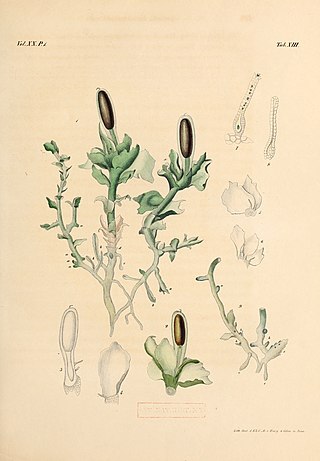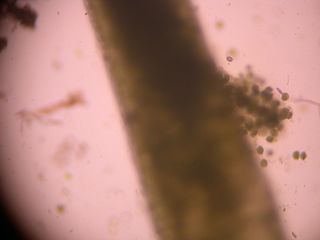
The Marchantiophyta are a division of non-vascular land plants commonly referred to as hepatics or liverworts. Like mosses and hornworts, they have a gametophyte-dominant life cycle, in which cells of the plant carry only a single set of genetic information.

Hornworts are a group of non-vascular Embryophytes constituting the division Anthocerotophyta. The common name refers to the elongated horn-like structure, which is the sporophyte. As in mosses and liverworts, hornworts have a gametophyte-dominant life cycle, in which cells of the plant carry only a single set of genetic information; the flattened, green plant body of a hornwort is the gametophyte stage of the plant.

Dendroceros is a genus of hornworts in the family Dendrocerotaceae. The genus contains about 51 species native to tropical and sub-tropical regions of the world.

Megaceros is a genus of hornworts in the family Dendrocerotaceae. The genus is found in the Old World tropics of east Asia and Australia. Its name means 'big horn', and refers both to the exceptionally large size of the gametophyte thallus and to the large, horn-shaped sporophyte that the plants produce. Many species have a branching thallus that is more than two centimeters wide. The gametophytes are monoicous.
Notothylas is a genus of hornworts in the family Notothyladaceae. The genus is found globally, but is usually overlooked. It is the smallest of all the hornworts, with a yellow-green gametophyte thallus that is seldom more than a centimeter in diameter, and usually much smaller.

The Notothyladaceae is the only family of hornworts in the order Notothyladales.

Anthoceros is a genus of hornworts in the family Anthocerotaceae. It is distributed globally. Species of Anthoceros are characterized by having a small to medium-sized, green thallus that is more or less lobed along the margins.

Haplomitriopsida is a newly recognized class of liverworts comprising fifteen species in three genera. Recent cladistic analyses of nuclear, mitochondrial, and plastid gene sequences place this monophyletic group as the basal sister group to all other liverworts. The group thus provides a unique insight into the early evolution of liverworts in particular and of land plants in general.

Blasiales is an order of liverworts with a single living family and two species. The order has traditionally been classified among the Metzgeriales, but molecular cladistics suggests a placement at the base of the Marchantiopsida.
Leiosporoceros dussii is the only species in the hornwort genus Leiosporoceros. The species is placed in a separate family, order, and class for being "genetically and morphologically distinct from all other hornwort lineages." Cladistic analysis of genetic data supports a position at the very base of the hornwort clade. Physical characteristics that distinguish the group include unusually small spores that are monolete and unornamented. Additionally, there are unique strands of Nostoc (cyanobacteria) that grow inside the plant parallel with its direction of growth. Unlike other hornworts with symbiotic cyanobacteria that enters through mucilage clefts, the mucilage clefts in Leiosporoceros is only present in young plants and then closes permanently once the cyanobacterial colonies have been established. Also mycorrhiza and pyrenoids are absent. Male plants have been found in Panama.
Cyanobionts are cyanobacteria that live in symbiosis with a wide range of organisms such as terrestrial or aquatic plants; as well as, algal and fungal species. They can reside within extracellular or intracellular structures of the host. In order for a cyanobacterium to successfully form a symbiotic relationship, it must be able to exchange signals with the host, overcome defense mounted by the host, be capable of hormogonia formation, chemotaxis, heterocyst formation, as well as possess adequate resilience to reside in host tissue which may present extreme conditions, such as low oxygen levels, and/or acidic mucilage. The most well-known plant-associated cyanobionts belong to the genus Nostoc. With the ability to differentiate into several cell types that have various functions, members of the genus Nostoc have the morphological plasticity, flexibility and adaptability to adjust to a wide range of environmental conditions, contributing to its high capacity to form symbiotic relationships with other organisms. Several cyanobionts involved with fungi and marine organisms also belong to the genera Richelia, Calothrix, Synechocystis, Aphanocapsa and Anabaena, as well as the species Oscillatoria spongeliae. Although there are many documented symbioses between cyanobacteria and marine organisms, little is known about the nature of many of these symbioses. The possibility of discovering more novel symbiotic relationships is apparent from preliminary microscopic observations.
Makinoa crispata is the only species of liverwort in the genus Makinoa and family Makinoaceae. The genus Verdoornia was formerly included in this family, but has been transferred to the family Aneuraceae on the basis of recent cladistic analysis of genetic sequences.
Pseudolepicoleaceae is a family of liverworts in the order Jungermanniales.

The Anthocerotaceae is the only family of hornworts in the order Anthocerotales.

The Dendrocerotaceae is the only family of hornworts in the order Dendrocerotales.

Nothoceros is a genus of hornworts in the family Dendrocerotaceae. The genus is found in New Zealand, South America, and neotropical and eastern North America.
Phymatoceros is the only genus in the hornwort family Phymatocerotaceae and order Phymatocerotales. It includes only two species.
Phaeomegaceros is a genus of hornworts in the family Dendrocerotaceae. It includes seven species.

Leiomitra is a genus of liverworts in the family Trichocoleaceae.

Casterlorum is a genus of fossil with controversial interpretation from the Middle Ordovician Douglas Lake Member of the Lenoir Limestone from Douglas Dam Tennessee The genus was named in honor of Ken Caster.









